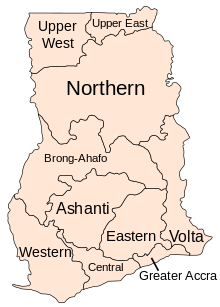Regions of Ghana
The regions of Ghana constitute the first level of subnational government administration within the Republic of Ghana. There are currently ten regions, further divided for administrative purposes into 216 local districts.
The current regional boundaries were officially established in 1987, when the Upper West Region was inaugurated as the state's newest administrative region. However, the Upper West Region had functioned as an administrative unit since the break-up of the Upper Region in December 1982, prior to the 1984 national census.[1]
| Region | Capital | Area (km2) |
Population (2010 census) [2] |
|---|---|---|---|
| Ashanti | Kumasi | 24,889 | 4,780,380 |
| Brong-Ahafo | Sunyani | 39,557 | 2,310,983 |
| Greater Accra | Accra | 3,245 | 4,010,054 |
| Central | Cape Coast | 9,826 | 2,376,021 |
| Eastern | Koforidua | 19,323 | 2,633,154 |
| Northern | Tamale | 70,384 | 2,479,461 |
| Western | Sekondi-Takoradi | 23,921 | 2,376,021 |
| Upper East | Bolgatanga | 8,842 | 1,046,545 |
| Upper West | Wa | 18,476 | 702,110 |
| Volta | Ho | 20,570 | 2,118,252 |
See also
- List of Ghanaian regional ministers
- List of Ghanaian regions by area
- List of Ghanaian regions by population
- ISO 3166-2:GH
References
This article is issued from Wikipedia - version of the 7/18/2016. The text is available under the Creative Commons Attribution/Share Alike but additional terms may apply for the media files.

